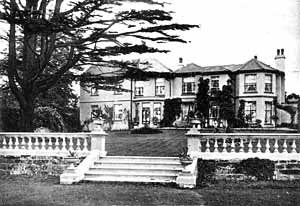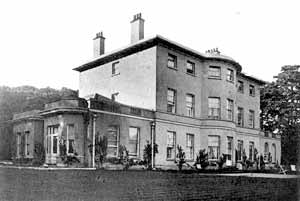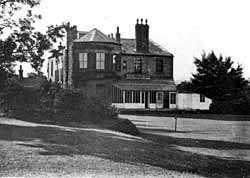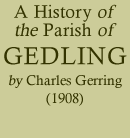< Previous | Contents | Next >
Gedling Manor.

Gedling Manor.
GEDLING MANOR, formerly called Gedling Lodge, was at one time a shooting-box of the Earls of Chesterfield. It formed part of an estate comprising 858 a. 3 r. 24 p. in the parishes of Gedling and Burton Joyce, which passed by descent from the Earls of Chesterfield to the Earls of Carnarvon. Our present King, Edward VII., when Prince of Wales, stayed at Gedling Lodge, on a visit to the late Earl of Carnarvon, during a shooting season. The Duke of Connaught, and the late Duke of Cambridge, were also frequent visitors to Gedling Manor. On 25 March 1901, the whole of this estate was sold by the present Earl of Carnarvon and his trustees to Weston Fulford Marriott Webb, Esq., of Nottingham. The Manor, which formed a detached portion of the estate, bounded on the east by the Great Northern Railway, and on the south by the road leading from Gedling to Burton Joyce, and comprising 28 a. 1 r. 16 p. was, on 1 December 1903, conveyed to Colonel William Henry Blackburn, the present owner and occupier.
Gedling House

Gedling House, from the south.
This interesting old Mansion, now the residence of Ald. Sir John Turney, Kt., J.P., was built about 1780.
By the kind permission of Walter H. Rawnsley, Esq., the owner, who lives at Well Vale, Alford, Lincs., and the courtesy of H. E. Thornton, Esq., Smith's Bank, we have had access to the Deeds relating to the property.
Without going into close details, we find that assignments of property date back to 1781.
The following advertisement of a sale of the property is worth reproduction :—
"Particulars of a very valuable and improvable estate, tythe free and Land Tax redeemed, situate in the parish of Gedling, (Notts.) consisting of a Mansion House, and other sundry houses and buildings, &c, in or near the Village of Gedling, together with 140 acres of excellent Land, which will be sold by Auction, by Mr. Gaskill, at his Sale Room in Nottingham, on Saturday, the 10th day of December, 1803."
Assignments, dated 1804, follow: Mr. Henry Wells to Rev. Thomas Beaumont, in trust for Wm. Elliott Elliott, Esq. Another lengthy and interesting Indenture, 27th March, 1804, sets out that the Estate and Mansion were purchased by W. Elliott Elliott, Esq., for a certain sum, witnessed by Thomas Smith, Banker, Nottingham, Mary, his wife, Robert, Lord Carrington, and Samuel Smith, Banker.
A supplementary purchase of Land from Lord Chesterfield by W. Stanford Burnside, Esq., of 1 rood 11½ perches, was made 7 December 1854.
A Close of Land, known as "Hall Wongs," 7 a. 3 r. 38 p. was purchased from Lord Chesterfield by Wm. Elliott Elliott, Esq., 27 November 1841.
A further conveyance of a Close of Land at Gedling, known as "Nether Meadow Close," 3 a. 2 r. 12 p. from Samuel Butler, of Carlton, to William Stanford Burnside, Esq., is dated 6 April 1870.
(The title of this property, owned by W. Bettison, is signed 14 October 1773.)
There is a further Conveyance of Property in Gedling and Stoke to W. H. Rawnsley, Esq., dated 4 June 1904.
Previous to leaving Hill House, East Bridgford, one of the members of the Beaumont family told the present writer that Hill House, (East Bridgford) was built by the same Architect as Gedling House, and at the same time, as at that period one house could be seen from the other, before the woods obscured the view.
Gedling was a place of great importance prior to the 19th century. We have it from the best authorities that various industries were followed in the village. There were workers in silk and cotton hosiery, frame-work knitters, lacemakers, and many basket makers.
Frame-work shops are still to be found in the village.
With reference to the latter industry the late Rector in his annual address to his parishioners, printed in the Parish Magazine for January 1881, remarked:—
"There used to be both in Gedling and Carlton a vast number of frame-work knitters, now Gedling does not boast of a single frame, and those in Carlton will have to give way before the revolution-making power of steam. The iron horse will be master everywhere."
Where Waverley Avenue now is, at one time there was a large "Hop Garden." Hops are now to be found growing there.
Though the "Chesterfield Arms" is now the only "Inn" in the village, four others were in existence about 1800, and prior to that date.
One public-house existed about the beginning of the 19th century where "Dovecote Farm " (Mr. Collishaw's) now is. Another was to be found at the east end of what now is Carnarvon Grove, the house that was occupied by the late Mr. Harrison. Another was to be found in the rectory grounds, near the present stables. Still one more existed where Mr. T. Palethorpe lives, just opposite the "Chesterfield Arms."
A large number of houses of some pretensions were to be found in the village many years ago, and it is within the memory of some who have lived in the village all their lives that a number of the houses were pulled down because of dilapidation, and not re-built. The old Workhouse at the corner of Stoke Lane, off the Burton Road, was pulled down about 1896.
The present Kennels, on the Lambley Road (the Earl of Harrington, Master) were built in 1875, and the first Joint-Masters were Percy Cooper, Esq., of Bulwell Hall, and Col. Rolleston, of Watnall Hall. J. German Shepherd was Huntsman, Jim Edwards, First Whip, and Charlie Dove, Second Whip. Sam Rawlinson, who was Kennel-man, has only just retired. The present (1908) Huntsman is Alfred Earp, First Whip, George Travis, Second Whip, Joe Jolland, Kennel-man, George Tinsley, Stud Groom, George Wilson.
Two previous Kennels were in existence, one where the old schools (opposite the rectory gates) now are, another stood near the Burton Road, opposite the old Workhouse, near the lodge to the Manor House, now the residence of Col. Blackburn.
The Parish Church was publicly re-opened, after many months restoration at a cost of £900, on Shrove Tuesday, February 13th, 1872, by the Bishop Suffragan of Nottingham.
On April 2nd 1872, the death took place of the wife of the Hon. Orlando W. W. Forester, Rector of Gedling. Mrs. Sophia Elizabeth Forester, born 18 January 1804, was a daughter of Richard Norman, Esq., and his wife, the Lady Elizabeth Manners, eldest daughter of the fourth Duke of Rutland, K.G., Lord Lieutenant of Ireland, and niece of the first Lord Forester. Mrs. Forester, who was married 14 July 1840, and had an only child, (the present Lord Forester), is interred in Gedling Churchyard. See page 62.
Near the Church, just outside the Rectory gates, a Drinking Fountain, with covered seats adjoining, was erected in 1874 by the late Countess of Carnarvon, and presented to the villagers.

The Fountain.
The following note appears in the Parish Magazine for June, 1874:—"One great boon to the village of Gedling will be accomplished before many weeks are gone by, in bringing the waters of Allwell Spring to the "Village Cross." The water is good, and will be free from such impurities as must, more or less, injure all well waters into which drainage will find its way. But we have been told that it is good tea water, and we will answer for its purity, so we must be content with these qualities—it is the same water which comes down the Dumble, with which we believe the villagers are now accustomed to do their laundry work, and if good for washing, and drinking, and tea, what more is wanted? That which comes to the fountain, will come direct from the Spring, before it has had any opportunity of suffering any defilement."
On Tuesday, October 5th, 1875, the marriage took place, at St. John's Church, Pimlico, of the Hon. and Rev. Canon Forester, Rector of Gedling, and Emma Maria, eldest daughter of William Tollemache, Esq., and his wife, Lady Anna Maria St. Maur, third daughter of the nth Duke of Somerset. On the wedding day the rector gave a substantial tea to the Church workers of the parish, and to the members of the Mothers' Meeting, nearly 300 in number. On November 4th, the rector and his wife came home, and received a hearty welcome. On alighting at Carlton and Gedling Station, where 200 school children were drawn up on the roadside, they drove under a triumphal arch to Gedling, where two arches were erected across the road, and one with the greeting "Welcome Home," over the gates of the rectory. On arriving at the Cross, Mr. and Mrs. Forester alighted, and received an address of welcome, to which the rector replied. The Gedling school children then sang "Home, Sweet Home," and with many cordial greetings, Mr. and Mrs. Forester retired to the rectory, amid cheers.
The choir of Gedling Church, mentioned on pages 61, 62, and 69 ante, is thus referred to in the Parish Magazine for October, 1878:—"We have heard comparisons made this year as to the manner in which the musical part of the service was done at Gedling, and assertion that Nottingham's smartest Churches would have been complimented under such circumstances. There is no question as to the improvement in Gedling Choir during the last eight or nine months. Much credit is due somewhere; perhaps somewhere should be read everywhere. The singers have taken pains, and have been attentive at the practice, and appear to take pride in their work, as they very justly may. There is also another reason." (The latter reason is not stated.)
At a concert promoted by the Gedling Cricket Club, held at Gedling, April 28th, 1879, the following humorous song, written by an old cricketer, and older inhabitant of Carlton, was sung by the composer, "in his old style," and was received with great applause. The song describes the progress made at Gedling during the previous few years, and is entitled :—
"GEDLING, PAST AND PRESENT."
1
"Gedling we know is a rising: place;
They've got a new clock, which has more than one face,
It strikes its hour, and likewise its quarters.
To rouse all those Gedling sons and daughters.
Chorus.—
"Up and down Gedling you can walk about free,
And hear this new clock strike its one, two, three.
2
"You can see it all over Gedling with half an eye,
And also from Carlton if you only just try;
The Rector's determined to please the people,
So he put a lot of new dials in the old church steeple.
"Up and down Gedling, &c.
3
"You've got a new fountain, it stands on the Cross,
And gives very good water for man and for horse,
And close by stands the blacksmith's shop,
But it wants two new sides and a good new top.
"Up and down Gedling, &c.
4
"You've got some good roads, and a fine set of bells,
And a pretty good crop both of boys and girls;
And you've got some new lamps to make your town brighter,
And to make it still better, a first-class lamplighter.
"Up and down Gedling, &c.
5
"You've got a new station, and a new railway,
For threepence to Nottingham, if you'll just go and pay;
You've got a coal wharf, and all know what it's done,
Why! it's brought coals down just four shillings a ton.
"Up and down Gedling, &c.
6
"At each end of your town you've got a good tailor,
You've got three or four shoemakers, and one a good nailer;
You've got some good cricketers who seldom miss catches,
And last summer played Carlton two very good matches.
"Up and down Gedling, &c
7
"Then there's Mr. P. Godfrey, with whom let's have a word,
And his opposite neighbour, who's Mr. James Bird,
The one he sells milk, and the other sells coals,
One it fattens the body, and t'other warms souls.
"Up and down Gedling, &c.
8
"You've a gentleman keeps the "Chesterfield Arms,"
He's a fine lot of bees, and often has swarms,
One hot summer's morning the bees would not rest,
So he'd three swarms before dinner and one very good cast.
"Up and down Gedling, &c.
9
"You've got fine new kennels, and they're seen very plain,
And part of a new town near to Westdale Lane;
And you've got a great cannon to guard your town,
A sergeant, a squire, and an Admiral Brown.
"Up and down Gedling, &c."
Within a stone's throw of the Fountain, on the main road, is the Village Club and Institute. This was opened March 21st, 1881, the cost, about £170, being defrayed by public subscription. The Earl of Carnarvon gave the site on which the building was erected, and the materials of an old cottage. The President is Lord Carnarvon; Vice-President: Lt.-Col. W. H. Blackburn; Hon. Sec: Mr. B. White; Hon. Treas.: Mr. C. Gerring. The Committee of six members is elected annually. The requirements of the members are well catered for, there is a good billiard table, which has recently been re-covered, &c, the skittle alley was much enlarged two years since, and the whole of the gas lighting arrangements have recently been renewed.
Opposite the Club are the "Old Schools," now utilized as a "Technical Night School," &c. under the direction of Mr. Luther Rutherford.
The National Schools situated on the main road, were built about 1890. The head master is Mr. J. W. Tebbey. Owing to the constant increase of population, there is necessarily frequent trouble with regard to accommodation.

The Rectory.
On April 18th, 1883, the Rector of Gedling attained his seventieth birthday. To celebrate the event his parishioners at Carlton and Netherfield presented him with a large and elegant silver candelabrum, inscribed:—"To the Hon. and Rev. Orlando W. W. Forester, M.A., Rector of Gedling, Canon and Chancellor of York—A token of esteem and affection from his attached parishioners at Carlton and Netherfield, on his completing ' three score years and ten,' April 18th, 1883." The presentation was made at the Working Men's Hall at Carlton, when the Chairman, the Rev. Kirke Swann, M.A., thus referred to the work the Rector had done during the preceding sixteen years:—"He had restored the large Parish Church, he had provided Mission Churches at Carlton and Netherfield, Schools at Carlton, Netherfield, and Stoke; the Large Hall and Institute where they were then assembled, and Institutes at Gedling and Netherfield; to these great boons to them and their neighbours, the Rector had contributed freely out of his own purse; in building the Carlton Institute, the Mission Room, School, and Club Rooms at Netherfield, he had given the whole cost."
The Gedling Cricket Club has been in existence for many years. The Cricket field, with Pavilion, adjoins "the Grange," (residence of F. C. Bird, Esq.) Mr. J. Savidge has been its Captain for a long period, and the success of the Club has been above the average of village clubs. The present Captain (1908) is F. C. Bird, Esq., and the Hon. Sec. is Mr. R. W. Savidge.
A Hockey Club was instituted in 1907, their playing piece is on the Burton Road, the Hon. Sec. is Mr. Charles Wainwright.
The Gedling Choral Society has been in existence for over six years, it has done excellent work, holding its practices in the School, during the winter season. It has given two concerts or performances annually, and during the last season gave a fine rendering of selections from Mendelssohn and Gounod in the Parish Church, for the benefit of the Gedling Nursing Association Fund. Mr. C. Gerring has been its conductor (3 years) and president (3 years), the membership numbers about 50.
The names of the Officers and Members of the Parish Council (1908) are given below :—
Mr. A. C. Wainwright (Chairman)
Mr. G. Clarke (Vice-Chairman)
Mr. James Wright (Treasurer)
Mr. H. Collishaw (Clerk); and
Messrs. J. Hemstock, W. Horsepool, S. Rawlinson, T. N. Parr, T. Palethorpe, R. W. Savidge, C. Bellamy.
Overseers :—Messrs. A. C. Wainwright and David Thompson.
Mr. Henry Taylor is the Gedling Member of the Basford Board of Guardians, and Rural District Councillor.
Farms:
ACREAGE. |
||
| Podhaugh, or Podder | 199 | Mr. T. N. Parr. |
| Gedling Wood Farm | 20 | Digby Colliery Co. |
| Gedling Lodge Farm | 26 | St. Andrew's Golf Club. |
| Marshall's Hill Farm (Carlton) | ... | Mr. Robert Butler. |
| Chase Farm (part of old Thorneywood Chase) |
50 | Digby Colliery Co. |
| { Lambley Lane Farm | 96 | Mr. Jas. Hemstock. |
| { Glebe Farm | ||
| Duncroft Farm | 86 | Mr. Frederick Sheppard. |
| Dovecote Farm | 24 | Mr. Henry Collishaw. |
| Willows' Farm | 70 | Mr. W. Musson. |
| { Rectory Farm | 17 | Mr. W. Straw. |
| { Glebe Farm | ||
| Church Farm | 83 | Mr. A. Lamb. |
| Town End Farm | 124 | Mr. T. N. Parr. |
